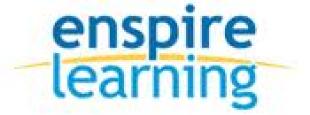Enspire Learning: Creating eLearning Courses that Engage & Inform


One of the highlights of writing this blog is featuring some of the really innovative elearning design making its way into the OpenSesame elearning marketplace. Enspire Learning is the newest addition to the community of course sellers, and they have some of the coolest courses I’ve seen in awhile.
Enspire’s staff is made up of folks with unconventional backgrounds bringing a rock’n’roll, Austin, Texas-inspired approach to elearning design. The Enspire courses in the OpenSesame catalog - Fluent in Finance and Mastering Management: Coaching - illustrate an innovative way to engage learners in practicing their skills and immersing themselves in learning environments.
Enspire course developers Nathan Kracklauer and Lytton Gilliland graciously shared their insights on how approach the design process. With diverse educational backgrounds (mathematics and astronomy, specifically), these guys don’t color inside the lines.
Tell us a little bit about how you got interested in elearning.
NK: At the time I started working for Enspire, I was looking for a day-job to support my rock'n'roll habit. I interviewed with the three founders in the original office: their apartment. For me, it was a stop-gap measure to earn money for three or four months, writing a 20-hour e-learning curriculum in business statistics for Harvard Business School. Nearly ten years later, I'm still with the company, partly because it turned out that designing learning experiences was far more creative than playing rock'n'roll.
A Unique Approach
What’s unique about Enspire's approach to building elearning content?
NK: Our approach depends on the type of problem we are trying to solve, of course. However, we tend to work mostly on the type of problem where we are helping someone transition into a new community of practice, for example an individual contributor becoming a manager, or a manager becoming a leader. When people make these transitions, they need to do far more than just learn some new facts and practice some new skills. These transitions involve fundamental changes in the way the learner looks at the world on the one hand, and herself on the other. I'd argue that what's unique in our approach is that we focus on supporting the learner in this deeply personal transition.
LG: We focus on our strengths: Building simulation-rich multimedia elearning courses to meet both broad market needs and unique customer needs. I work with my teammates to develop complex scenarios and original stories that illustrate different concepts. This creative, free process generates courses that are fun for learners to jump into and fun for us to build.
We build branching scenarios with interesting conversations and simulations, which continually stimulate the learner. We develop the content by working with both external and internal subject matter experts to make sure our simulations really express the reality of the learning need.
Research & Design
 What’s your research and design approach?
What’s your research and design approach?
NK: Building on the idea that we are helping people through a transition into a new understanding of the self, I think it's important to understand what's driving the typical learner during that life transition: economically, emotionally, socially, etc. What pressures does she face from work, family-life, and from within herself? This helps us anticipate when we need to support flagging confidence and motivation in a learning experience, and when we need to challenge the learner with something new and difficult. So the main research task is to understand typical audience members and design in a way that meets their needs.
What technology developments are you most excited about?
NK: Although I'm not exactly a Luddite, "technology" is not something I tend to get excited about. I would say that I'm generally excited about any technology that liberates great teachers from being conduits of information and allows them to do what they do well: engage learners and help them reach insights themselves. Too often, teachers and instructors are forced to spend a lot of time communicating facts. Anything that takes that burden from them and gives them more time to facilitate discussions -- and e-learning is a wonderful tool for that -- is a great thing. I hope that ultimately, learning technology allows us to shift away from our current education model -- in which we front-load learning into the early part of our lives and deliver quality education to a relatively privileged few worldwide -- to a model in which a much broader segment of humanity can be life-long learners.
LG: I’m excited about building mobile learning apps that are more than just mobile apps for the sake of being mobile. I think the biggest challenge is figuring out why to make something for mobile environment, not how. Some of the most promising applications of mobile apps are as just-in-time learning aids, rather than an entire course.
What’s something unique about Enspire?
LG: People like each other and their work. My colleagues and I hang out together, and I believe that feeling of connection comes across in the work we do. Our strong relationships mean that we are personally accountable to everybody else.
NK: We made a point of hiring people with wide ranges of interests who are creatively engaged outside of the workplace in many different media: music, film, theater, you name it. This is true for every functional area of the company. When you design learning experiences on a wide range of topics for a wide range of audiences, you need people who can think laterally and learn whole new domains of knowledge rapidly. That's what you get when hire people with eclectic interests and creative outlets. It also makes for a fun and stimulating workplace.
Thanks to Lytton and Nathan for their time and insights. Take a look at Enspire Learning’s elearning courses and follow them on Twitter at @EnspireLearning.



